The chemistry of love is an entire neurochemical orchestra where each hormone can act as a neurotransmitter in the brain to play a specific role in creating, maintaining, or destroying romantic connection. When someone says “we have great chemistry,” they’re unknowingly describing the successful coordination of at least ten different brain chemicals working harmoniously. Understanding the individual players in the chemistry of love explains why romance feels so different with different people, why relationship timing matters so much, and why your brain sometimes betrays your best intentions when you’re in love.
Why Understanding Love’s Chemistry Matters
Understanding the chemistry of love matters because it explains why we feel drawn to certain people and indifferent to others even when all the external factors seem right. These reactions are each driven by specific neurochemical signals that shape attraction, desire, bonding, and even long-term compatibility. When you lock eyes with someone across a crowded room and within milliseconds, your brain is flooded with dopamine and sense signals to parts of your brain involved in the release of neurotransmitters that are responsible for that fluttering feeling we get when we’re attracted to someone or nervous.
Or perhaps you spend an evening with someone who is perfect on paper but for some reason you feel absolutely nothing for them. No butterflies, no heart skipping a beat, just stillness. Even that is a sign that the relationship between you and the person could go either way.
The chemistry of love operates like a sophisticated biological screening system, constantly evaluating romantic potential through cascading hormonal responses that happen far below our conscious awareness. While researchers are still unraveling the exact mechanism by which neurochemicals play a role in our love lives, what we do know is remarkable: your brain runs approximately ten different chemical programs simultaneously to determine romantic compatibility, each with its own timeline, intensity, and purpose.
The Key Hormones in the Chemistry of Love
Dopamine: The Neurotransmitter That Makes You Crave Them
Dopamine is the MVP of early attraction in the chemistry of love. This neurotransmitter activates your brain’s reward system, creating the euphoric “high” that makes you want to spend every waking moment with someone new. When dopamine floods your ventral tegmental area, it creates feelings identical to cocaine addiction literally. Your brain categorizes this person as a “reward,” motivating you to pursue them with sometimes irrational intensity. This explains why new relationships can feel all-consuming and why you might neglect friends, work, or sleep when attraction strikes.
Dopamine’s role in the chemistry of love also explains why intermittent reinforcement (hot-and-cold behavior) can feel so addictive. Your brain releases more dopamine when rewards are unpredictable, which is why unavailable people sometimes feel more chemically compelling than consistently available ones.
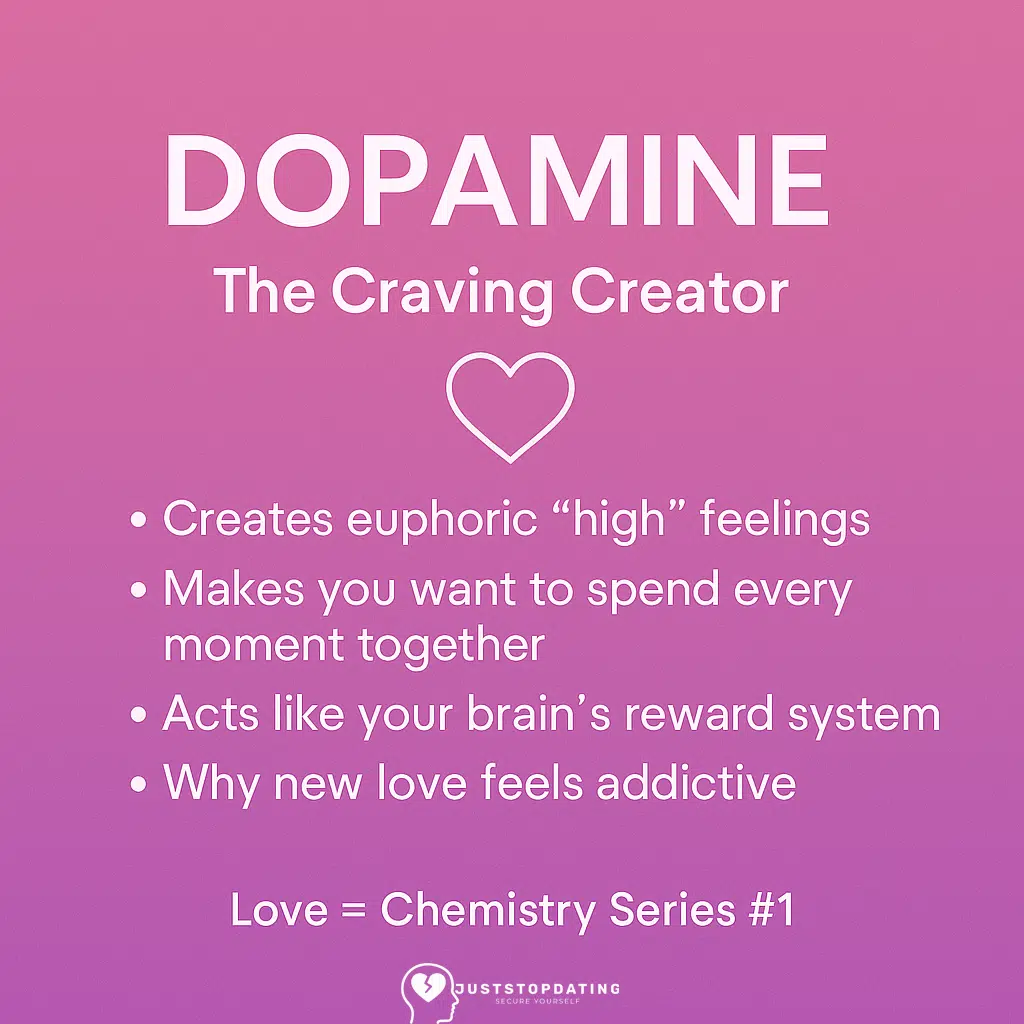
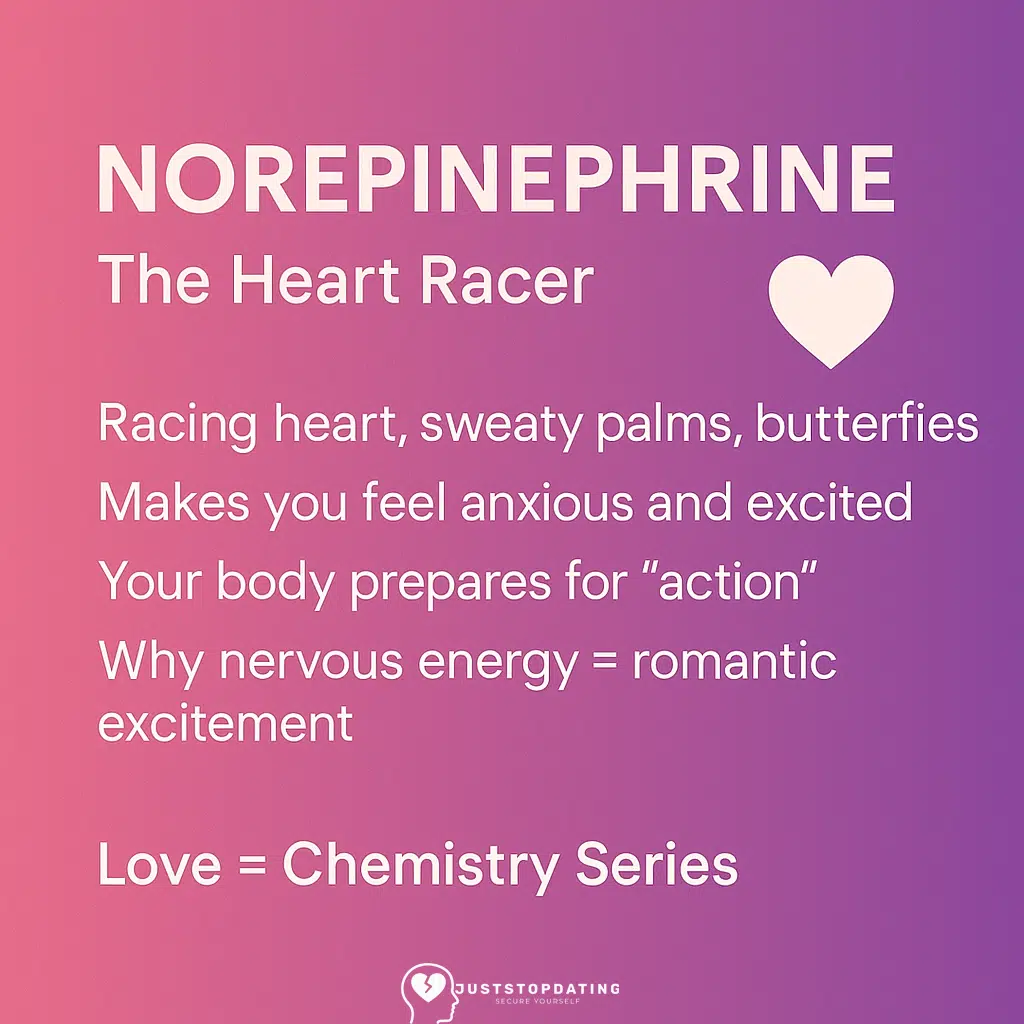
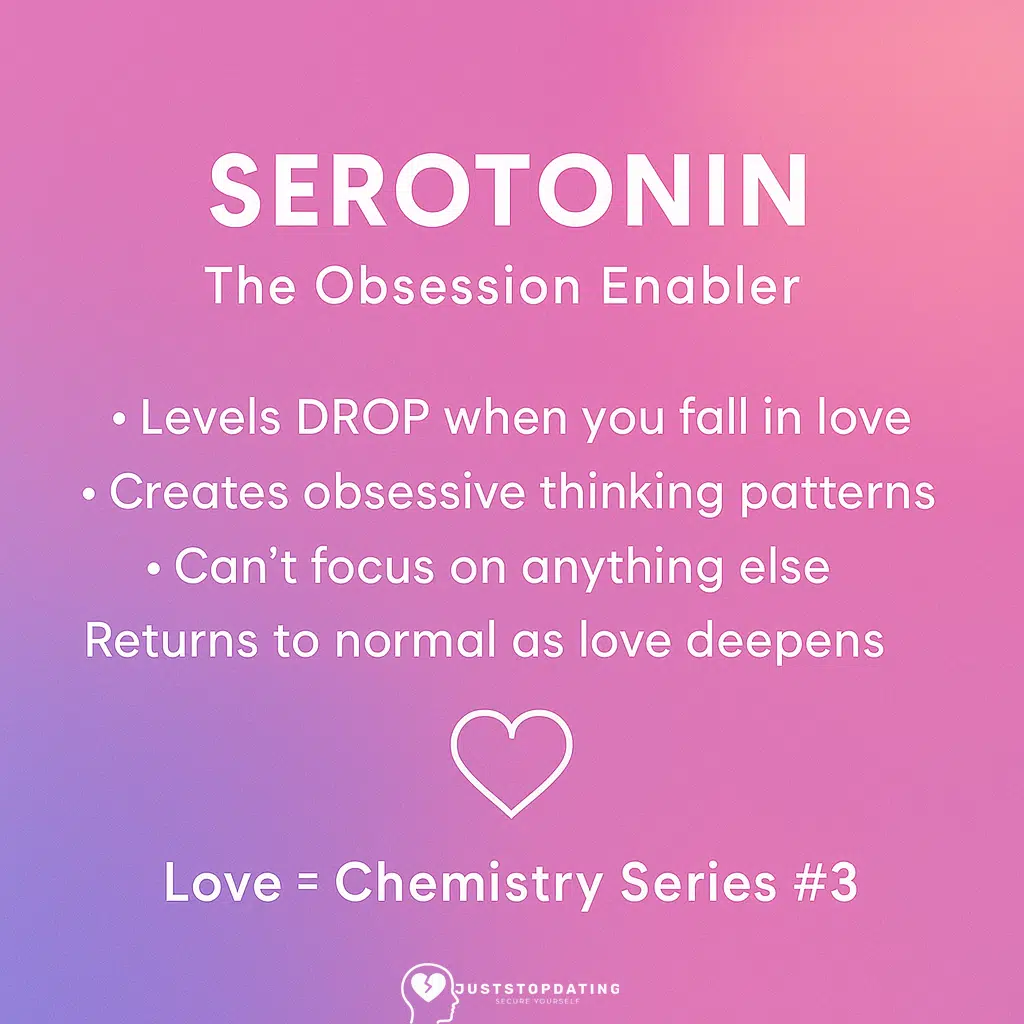

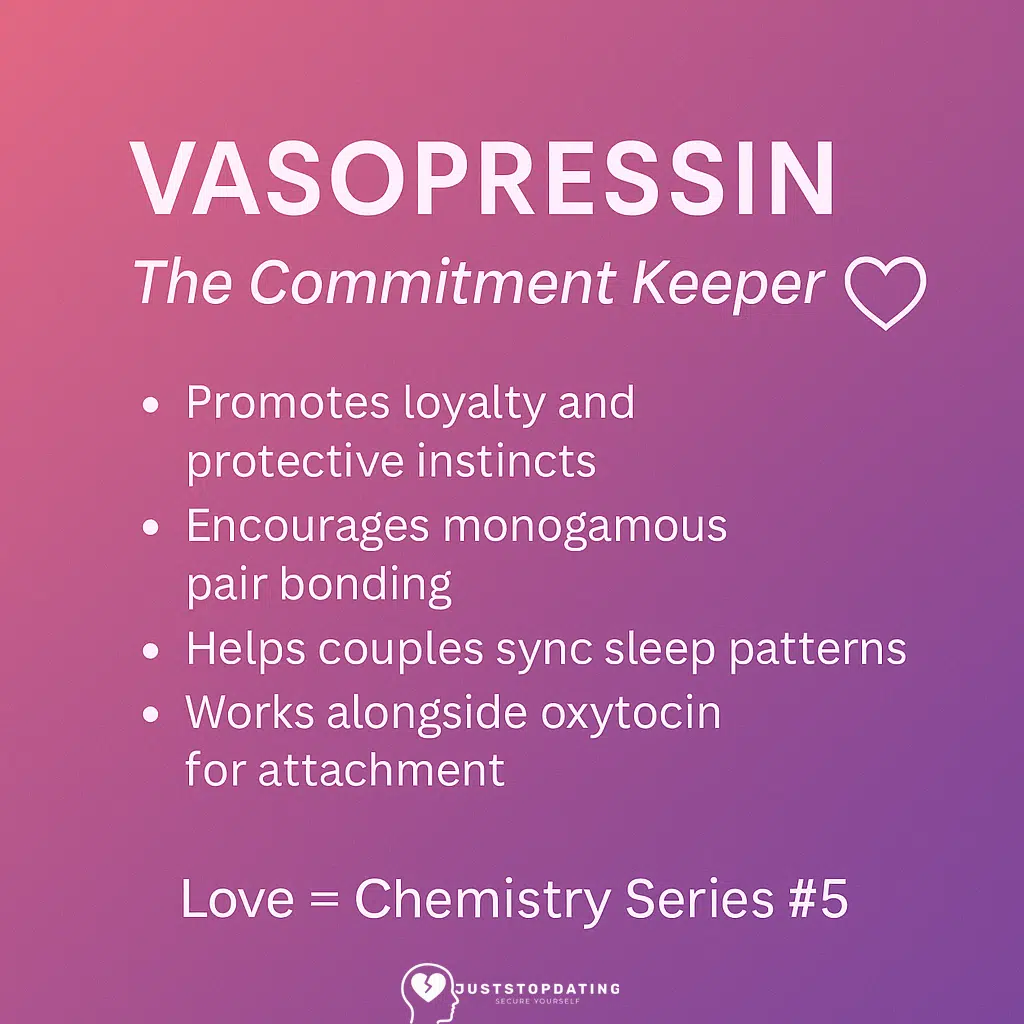
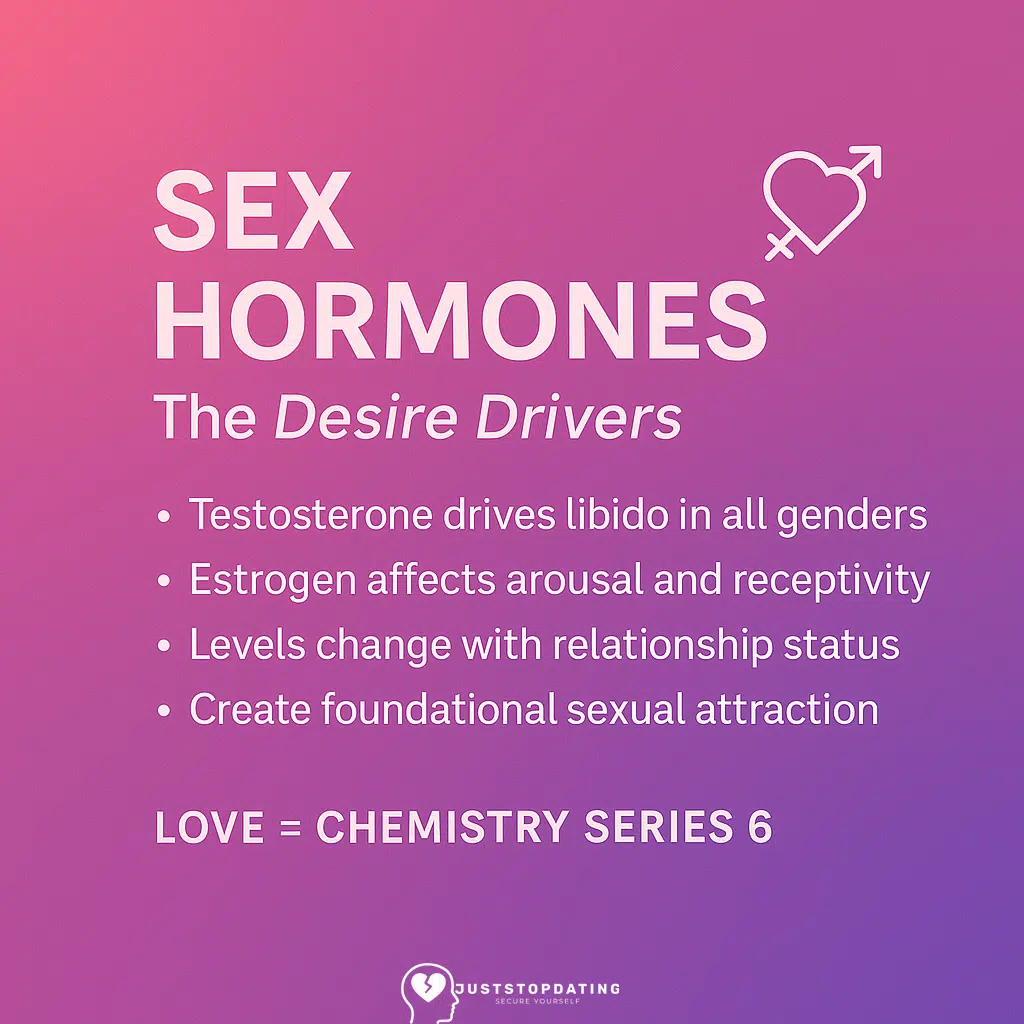

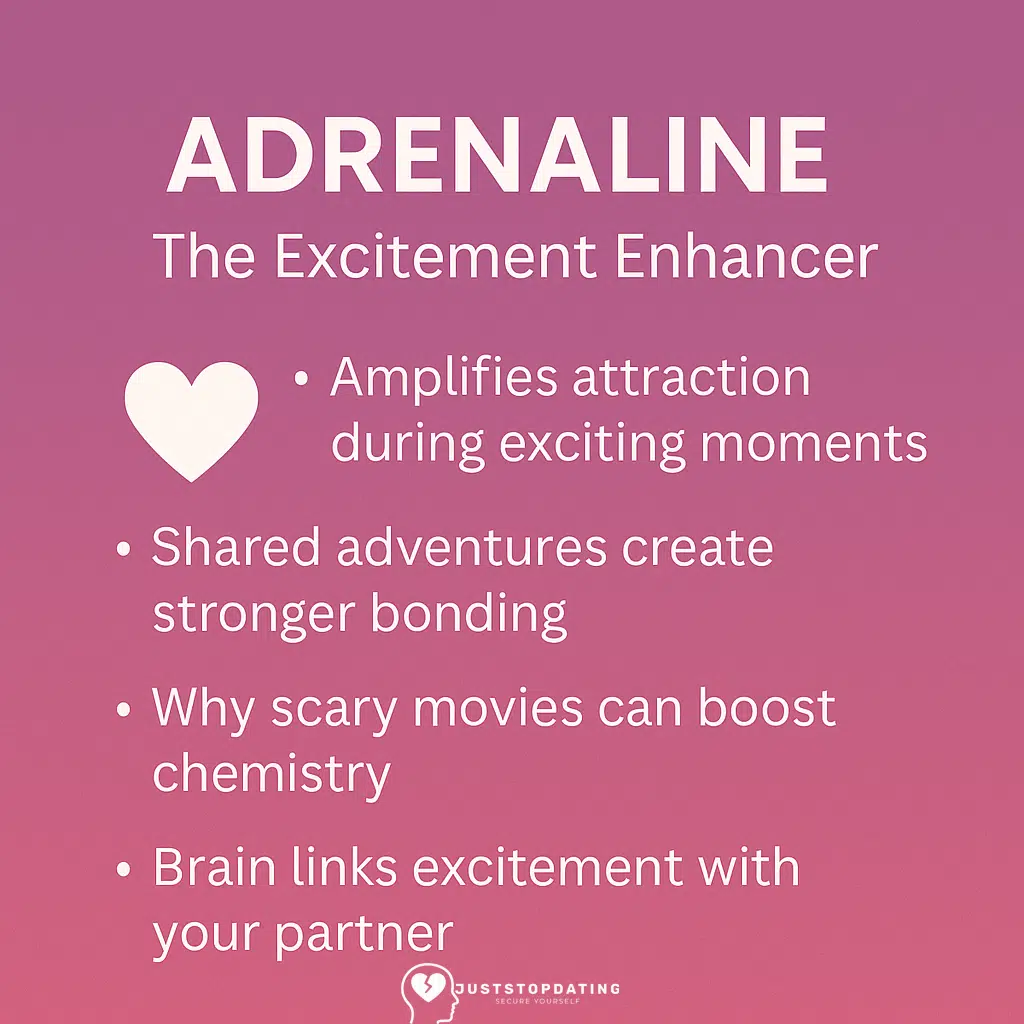
Norepinephrine: What Makes Your Heart Race
Norepinephrine (adrenaline) creates the physical symptoms of attraction in the chemistry of love racing heart, sweaty palms, butterflies, and that inability to sit still when you’re around your crush. This chemical puts your body in a state of arousal and alertness, preparing you for action. The norepinephrine surge also explains why early attraction can feel anxious and overwhelming. Your sympathetic nervous system activates as if you’re facing a threat, except the “threat” is someone you’re attracted to. This is why nervous energy and romantic excitement feel so similar they’re mediated by the same neurochemical.
Interestingly, norepinephrine can create attraction through misattribution. If you meet someone during a stressful or exciting situation, your brain might interpret the adrenaline as romantic chemistry, creating what researchers call “misattribution of arousal.” (Elkins-Brown et al., 2018)
Serotonin: The Mood Regulator
Here’s where the chemistry of love gets counterintuitive: serotonin levels actually decrease when you’re falling in love. Low serotonin creates the obsessive thinking, constant preoccupation, and inability to focus on anything else that characterizes early romantic attraction.
This serotonin drop mirrors patterns seen in obsessive-compulsive disorder, which explains why love can feel so mentally consuming. Your brain literally becomes less capable of thinking about anything other than your romantic interest when serotonin decreases.
The good news? Serotonin levels typically normalize as relationships progress from attraction to attachment, allowing your brain to regain its ability to focus on other life areas.
Oxytocin: The Bonding Hormone for Connection
Oxytocin is the star of long-term attachment in the chemistry of love. Released during physical touch, eye contact, and intimate moments, this hormone creates feelings of trust, safety, and emotional bonding.
Unlike dopamine’s addictive intensity, oxytocin creates calm, secure feelings that deepen over time. It’s released during sex, cuddling, and even meaningful conversations, literally rewiring your brain to feel connected to this specific person.
Oxytocin also has an interesting property: it amplifies whatever emotion you’re already feeling. If you’re happy and secure, oxytocin enhances those feelings. If you’re anxious or upset, it can intensify those emotions too. This is why physical intimacy can either strengthen or strain relationships depending on the emotional context.
Vasopressin: The Commitment Chemical (Especially for Men)
Vasopressin works alongside oxytocin in the chemistry of love but plays a particularly important role in male bonding and territorial behavior. This hormone promotes mate-guarding, loyalty, and protective instincts toward romantic partners. Research shows men with higher vasopressin levels are more likely to form monogamous pair bonds and show increased partner protectiveness. Men with genetic variations affecting vasopressin receptors often struggle with commitment and relationship stability.
Vasopressin also regulates circadian rhythms, which explains why disrupted sleep patterns can affect relationship bonding and why couples often naturally sync their sleep-wake cycles.
Estrogen and Testosterone: Sex Hormones
These sex hormones provide the foundational layer of the chemistry of love by creating sexual desire and physical attraction. Testosterone drives libido in both men and women, while estrogen affects sexual receptivity and arousal patterns. Testosterone levels fluctuate based on stress, health, age, and even relationship status (Holmboe et al, 2017). Men in committed relationships often show decreased testosterone, while single men seeking mates typically have higher levels (Burnham et al., 2003; Cromie, 2002; Gray et al., 2020).
For women, estrogen levels peak during ovulation, often creating stronger sexual responses and attraction to potential partners during fertile windows. This explains why attraction can feel stronger or weaker at different times of the menstrual cycle.
Endorphins: The Natural Mood Elevators
Endorphins in the chemistry of love create the peaceful, content feelings of established relationships. These natural opioids are released during physical intimacy, exercise, and stress, creating feelings of wellbeing and pain relief. Unlike dopamine’s excitement or oxytocin’s bonding, endorphins provide the comfortable, secure feelings that sustain long-term relationships. Endorphins are responsible for that “at home” feeling you get with the right person: calm, safe, and deeply content.
Endorphins also explain why breakups can feel physically painful. Your brain becomes accustomed to regular endorphin release from your partner’s presence, and withdrawal creates genuine physical discomfort similar to coming off opioids.
Prolactin: The Sexual Satisfaction Chemical
Prolactin is released after orgasm in both men and women, creating feelings of satisfaction and emotional closeness (Krysiak et al., 2016). This hormone promotes bonding and reduces sexual desire temporarily (explaining the refractory period), allowing couples to focus on emotional connection rather than just physical attraction.
Higher prolactin levels are associated with increased nurturing behavior and parental instincts. In the chemistry of love, prolactin helps shift focus from sexual pursuit to relationship maintenance and care-giving behaviors (Al-Chalabi et al., 2023).
Adrenaline: The Excitement Amplifier
Beyond norepinephrine, general adrenaline release during exciting or stressful situations can enhance the chemistry of love through arousal misattribution. Couples who engage in novel, exciting activities together often report stronger attraction because shared adrenaline experiences create bonding. This explains why adventure dates, scary movies, or even arguments can sometimes increase attraction. The adrenaline surge gets associated with your partner’s presence, creating artificial but real feelings of chemistry.
How These Chemicals Work Together (Or Don’t)
The chemistry of love isn’t about having high levels of all these chemicals simultaneously. Instead, it’s about the right chemicals activating at the right times in the right combinations. Healthy relationships typically progress from dopamine-driven attraction to oxytocin-based attachment, with appropriate levels of all supporting players. Problems arise when these systems get out of sync. Dopamine without oxytocin creates addiction-like attraction without bonding. Oxytocin without dopamine creates comfortable but passionless relationships. Understanding your own neurochemical patterns helps you recognize whether you’re experiencing healthy chemistry or chemical dysfunction.
Working With Your Love Chemistry
Understanding the chemistry of love empowers better relationship decisions. If you’re dopamine-driven, practice evaluating compatibility alongside attraction. If you’re oxytocin-dependent, allow time for bonding to develop before making major relationship decisions. Most importantly, remember that neurochemical responses provide information, not instructions. Your brain chemistry reveals compatibility and timing, but conscious choice determines relationship success. The goal isn’t to manufacture chemistry where none exists, but to recognize and nurture it when it’s genuinely present.
The chemistry of love is your brain’s sophisticated system for evaluating and creating romantic bonds. Each hormone and neurotransmitter serves a specific purpose in this complex process. Understanding their individual roles helps you trust your responses while making conscious choices about timing, compatibility, and emotional investment.









